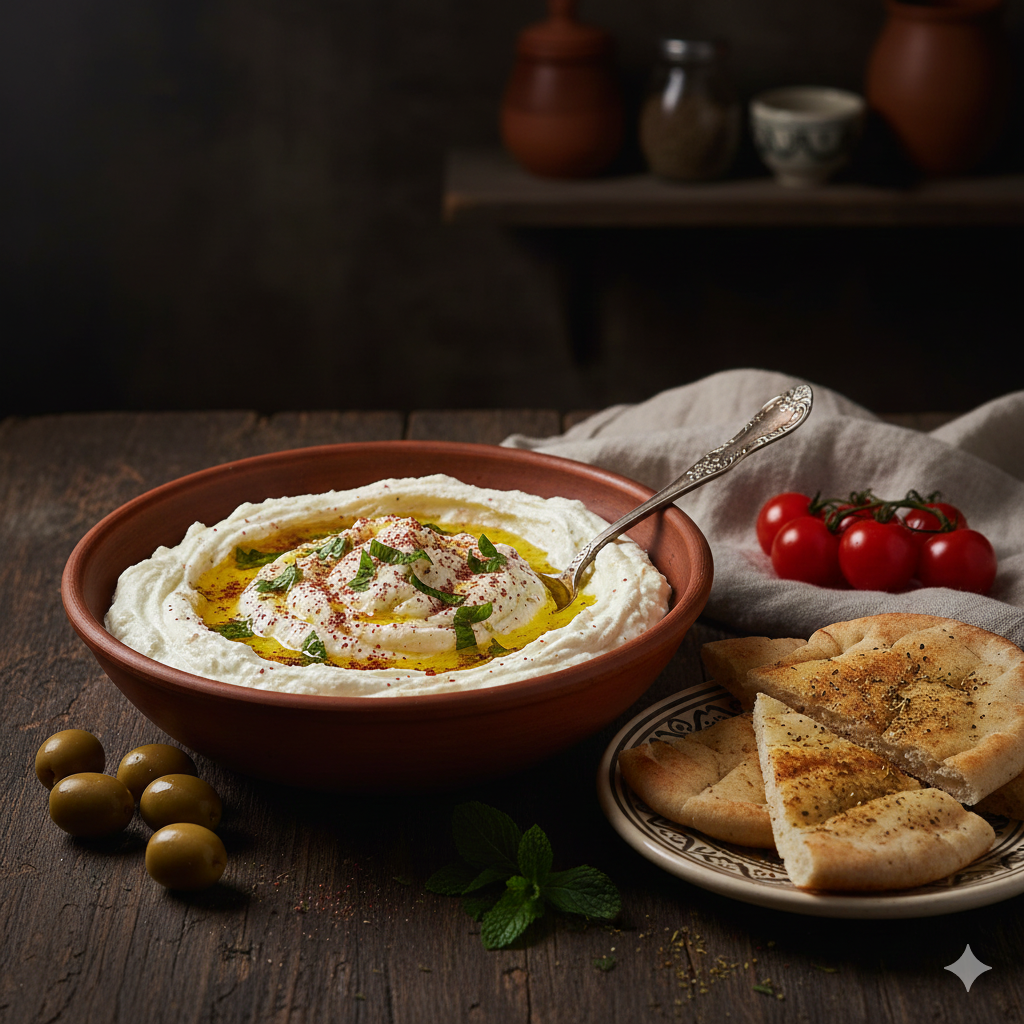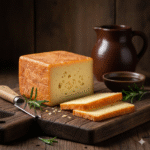Labneh—also known as labna, lebni, or strained yogurt cheese—is one of the oldest and most beloved dairy foods in the Middle East and Mediterranean. With its creamy texture, tangy flavor, and incredible versatility, labneh has become a global favorite. Whether you enjoy it as a dip, spread, or ingredient in savory dishes, labneh stands out as a nutritious, refreshing, and deeply cultural cheese-yogurt hybrid.
In this complete international guide, you’ll learn:
-
What labneh tastes like
-
Where labneh comes from
-
Turkish vs Lebanese labneh
-
How it differs from yogurt
-
The main types of labneh
-
How to pair labneh with foods
-
Whether labneh contains lactose
-
Nutrition facts and health benefits
Let’s dive into everything that makes labneh a timeless dairy treasure.
What Is Labneh?
Labneh is a thick, spreadable cheese made by straining yogurt to remove excess whey. The result is a smooth, creamy dairy product with the richness of cream cheese and the freshness of yogurt.
You’ll commonly find labneh:
-
Spread on flatbreads
-
Served as a meze dip
-
Rolled into balls and preserved in olive oil
-
Used as a base for sauces, dressings, or desserts
Its versatility is one reason it’s beloved across Lebanon, Turkey, Syria, Greece, and increasingly, the world.
What Does Labneh Taste Like?
If you’ve never tried labneh, you might wonder:
How does labneh taste?
Labneh has a mildly tangy, fresh, and slightly sour flavor, similar to thick Greek yogurt but richer and creamier.
Flavor Profile at a Glance
-
Tanginess: Mild to medium, depending on fermentation
-
Creaminess: Very high—soft, smooth, and spreadable
-
Saltiness: Lightly salted
-
Acidity: Balanced and refreshing
-
Aftertaste: Clean and creamy with yogurt notes
If you’re asking, “What does labneh taste like?”—the closest comparison is a lighter cream cheese crossed with Greek yogurt.
Where Is Labneh From?
Labneh Origin Country
Labneh is traditionally from the Levant region, which includes:
-
Lebanon
-
Syria
-
Palestine
-
Jordan
However, its preparation techniques are ancient and can be traced back thousands of years. Some historians believe that early nomadic groups strained yogurt for preservation long before refrigeration—giving rise to what we now call labneh.
Today, variations of labneh are enjoyed across:
-
Turkey
-
Greece
-
Cyprus
-
Armenia
-
Iraq
-
North Africa
It has become a staple in both Mediterranean and Middle Eastern cuisine.
Turkish Labneh vs Lebanese Labneh
Labneh varies subtly by region. The most common comparison is between Turkish and Lebanese versions.
Turkish Lebni (Lebni / Labne)
-
Softer and smoother
-
Often eaten as a breakfast cheese
-
Mild flavor
-
Slightly less tangy
-
Sold in tubs similar to yogurt
Lebanese Labneh
-
Thicker and denser
-
Stronger tangy flavor
-
Often rolled into balls
-
Frequently paired with olive oil, za’atar, or herbs
Which Is Better?
It depends on your preference:
-
Prefer mild and creamy? → Turkish labneh
-
Prefer tangy and rich? → Lebanese labneh
Both are delicious and can be used interchangeably in most recipes.
Labneh vs Yogurt: What’s the Difference?
People often wonder whether labneh is yogurt or cheese. Technically, it’s both.
Key Differences
| Feature | Yogurt | Labneh |
|---|---|---|
| Texture | Soft, spoonable | Thick, spreadable |
| Water Content | High | Low (strained) |
| Flavor | Mild, tangy | Creamier, slightly stronger |
| Use | Eaten plain, sweetened | Spread, dip, savory dishes |
| Category | Fermented dairy | Strained yogurt cheese |
Labneh is basically concentrated yogurt, making it more nutrient-dense and higher in protein.
Types of Labneh
Labneh comes in several varieties depending on preparation, ingredients, and regional traditions.
1. Traditional Labneh
Strained from cow’s or goat’s yogurt; the classic soft, spreadable type.
2. Labneh Balls (Labneh Makbous)
Rolled into small balls, stored in jars filled with olive oil and spices.
3. Goat Milk Labneh
Stronger, more rustic flavor with a creamy-firm texture.
4. Low-Fat Labneh
Made from low-fat yogurt; lighter in taste and calories.
5. Sweet Labneh
Drizzled with honey or fruit syrup; used in desserts.
6. Flavored Labneh
Infused with:
-
Za’atar
-
Mint
-
Garlic
-
Chili
-
Olive oil
-
Pomegranate seeds
These artisan versions are popular in gourmet stores.
How to Eat Labneh: Best Uses & Pairings
Labneh is one of the most versatile dairy products you can keep in your kitchen. Here are the best ways to enjoy it.
1. As a Dip (Classic Meze Style)
Simply drizzle olive oil and add a pinch of za’atar. Serve with:
-
Pita bread
-
Cucumbers
-
Olives
-
Cherry tomatoes
2. On Toast or Sandwiches
Use labneh instead of cream cheese for a healthier, tangier option.
3. In Salads
Whisk labneh with lemon and herbs to make a refreshing dressing.
4. As a Sauce
Perfect for grilled meats, kebabs, falafel, and roasted vegetables.
5. In Desserts
Mix with honey, vanilla, or fruit for a creamy treat.
6. As Labneh Balls
Roll into small balls and preserve in olive oil with herbs—great for charcuterie boards.
7. Cooking Substitute
Labneh can replace:
-
Sour cream
-
Cream cheese
-
Greek yogurt
Does Labneh Have Lactose?
Labneh has less lactose than regular yogurt because a significant amount of lactose-rich whey is removed during straining.
However, it still contains some lactose.
Many people with mild lactose intolerance tolerate labneh well, thanks to:
-
Fermentation
-
Lower whey content
-
Probiotics
But for highly sensitive individuals, moderation is recommended.
Nutrition Facts & Health Benefits
Labneh is nutrient-dense and packed with beneficial bacteria.
Nutrition (per 100g)
-
Calories: ~150
-
Protein: 10–12g
-
Fat: 7–11g
-
Carbohydrates: 4–6g
-
Calcium: High
-
Probiotics: High
Health Benefits
✔ Supports gut health
✔ Rich in protein for muscle repair
✔ Lower lactose content than yogurt
✔ High in calcium for strong bones
✔ Contains healthy fats
✔ Aids digestion
✔ Versatile for weight-friendly meals
FAQ About Labneh
1. What does labneh taste like?
Labneh tastes creamy, tangy, and slightly sour—similar to Greek yogurt but thicker and richer.
2. Where is labneh from?
Labneh originates from the Levant region—Lebanon, Palestine, Syria, and Jordan.
3. Is labneh Turkish or Lebanese?
Both countries have their own variations. Lebanese labneh is thicker; Turkish lebni is smoother and milder.
4. What is the difference between yogurt and labneh?
Labneh is strained yogurt that becomes thicker and creamier, often eaten as a cheese-like spread.
5. Does labneh have lactose?
Yes, but less than regular yogurt due to the straining process.
6. Is labneh healthy?
Absolutely—labneh is high in protein, calcium, and probiotics.
7. How long does labneh last?
-
Fresh labneh: 5–7 days
-
Labneh balls in oil: 2–4 weeks



